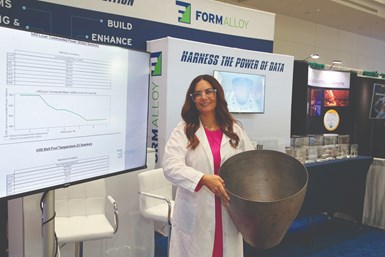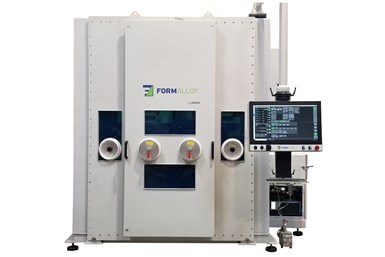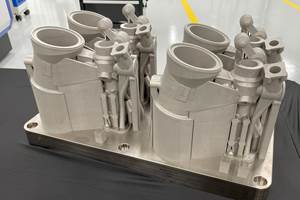AM Bridges High-Stakes Supply Chain Gaps
Gaps in the supply chain can create greater risks with far larger real-world consequences.
Melanie Lang, co-founder/CEO of FormAlloy, holds a 3D printed Rocket Nozzle made of a nickel-based superalloy (Inconel625) from FormAlloy’s directed energy deposition system. Photo Credit: AMT
It’s less the case today, but last year it seemed like any and all inconveniences could be attributed to problems in the supply chain. Did the grocery store run out of your favorite toothpaste? Supply chain. Is the couch you ordered expected to arrive sometime after “The Twelfth of Never”? Oh, that’s the supply chain’s fault for sure. Does your back hurt? I don’t know how, but it’s probably the supply chain.
For most consumers, the stakes for supply chain issues were pretty low. Having to switch brands of deodorant or sit for another three months on a couch you’ve sat in for a decade wouldn’t be the end of the world. In other scenarios, however, gaps in the supply chain can create greater risks with far larger real-world consequences — say, for instance, on the battlefield.
“A big challenge is the ability to support and repair legacy systems on demand,” says Melanie Lang, co-founder and CEO of FormAlloy, a metal AM technology company. Lang notes that, as sophisticated as it is, today’s military still relies on older systems that are still in operation and have not yet been replaced or modernized.
“Today, you have highly sophisticated military systems in the field that have been deployed and used beyond the life they were originally designed for,” she says. “It’s good they have continued to meet the demands, but it can create maintenance and supply chain challenges because you have hard-to-replace parts, and it’s hard to predict when that’s going to happen.”
Even when these systems need repair in the U.S. (on a base rather than in a forward deployment area), it isn’t as though there’s a Home D-O-Depot for specialized parts in a legacy weapons system around the corner. “Even if you were located somewhere on a base in the U.S., there’s no guarantee that you are going to be able to find the same exact part for this piece of equipment, which again may have been designed decades ago,” Lang says. The metal AM technology can also support modernization efforts by providing parts with enhanced performance or life, and again the on-demand repair and replacement.
The FormAlloy L-Series DED features the ability to build, enhance or repair components with single or multimaterial structures.
To the issues of finding the right part, in the right place at the exact right time, AM provides an elegant solution. Rather than having to scramble to find a replacement part when something breaks or having to rejigger what’s available to provide a temporary fix, companies like FormAlloy can design and make the part right away. With AM, the replacement part can be built quickly — and to the exact system specifications — providing a much better option than a kludge to tide things over.
Lang notes that with advanced additive processes and, specifically, direct energy deposition (DED) — which is FormAlloy’s specialty, “you can also make superior performance parts using superior materials and multiple materials
in a single build.”
Not only does additive mean you’re getting a custom-designed part to fix the system — you can also get a part that performs better than the one it replaced. “For example, the replacement part can use some type of corrosion- or wear-resistant material to extend its life further,” she says. “This technology isn’t just meant to be used to sustain older systems, but also to produce really high-quality, high-performing components.”
Beyond just quickly produced, better-performing custom parts, what Lang’s company and others like it are aiming to provide is greater certainty to their customers, military or otherwise. An organization’s leadership can make better decisions and take bolder risks knowing that if and when a critical part breaks in their existing system, they won’t have to cross their fingers and hope the supply chain comes through for them. There’s an additive solution for that, no matter what “that” is.
Lang’s work in the additive world also illustrates the importance of reshoring, not as a hollow political or patriotic gesture, but as plain old common sense.
“If we’ve learned anything in the pandemic, it’s that it’s very important to keep manufacturing somewhat local,” she says. “There are all kinds of issues you might face when sourcing abroad — lead time challenges, material delays. If we can use additive technology and its power to produce things locally or regionally, you can avoid many supply chain challenges and delays.”
Gain more insight from Lang in her interview on IMTS+ and other AM industry leaders at IMTS.com/Watch.
Related Content
The Cold Spray Solution to the Casting, Forging Supply Chains
Startup HAMR Industries performs additive manufacturing work at Neighborhood 91 that provides an alternative to traditional casting and forging. Success so far has led to redefining the limits of its additive equipment.
Read MoreWhy AM Leads to Internal Production for Collins Aerospace (Includes Video)
A new Charlotte-area center will provide additive manufacturing expertise and production capacity for Collins business units based across the country, allowing the company to guard proprietary design and process details that are often part of AM.
Read MoreNext-Gen Horse Trailers to Be Built With Robotic 3D Printing
Double D Trailers is currently developing a prototype horse trailer that will be made with large-format additive manufacturing. The technology brings potential benefits for labor, weight and design features to this subset of recreational vehicles.
Read MoreSeurat: Speed Is How AM Competes Against Machining, Casting, Forging
“We don’t ask for DFAM first,” says CEO. A new Boston-area additive manufacturing factory will deliver high-volume metal part production at unit costs beating conventional processes.
Read MoreRead Next
At General Atomics, Do Unmanned Aerial Systems Reveal the Future of Aircraft Manufacturing?
The maker of the Predator and SkyGuardian remote aircraft can implement additive manufacturing more rapidly and widely than the makers of other types of planes. The role of 3D printing in current and future UAS components hints at how far AM can go to save cost and time in aircraft production and design.
Read More3D Printing Brings Sustainability, Accessibility to Glass Manufacturing
Australian startup Maple Glass Printing has developed a process for extruding glass into artwork, lab implements and architectural elements. Along the way, the company has also found more efficient ways of recycling this material.
Read MoreHybrid Additive Manufacturing Machine Tools Continue to Make Gains (Includes Video)
The hybrid machine tool is an idea that continues to advance. Two important developments of recent years expand the possibilities for this platform.
Read More

















